Physical Address
304 North Cardinal St.
Dorchester Center, MA 02124
Embryologic development of the kidneys is completed by the 36th gestational week. Residual embryonic fetal tissue (metanephric blastema) that persists beyond 36 weeks' gestation is called a nephrogenic rest . Multifocal or diffuse nephrogenic rests are termed nephroblastomatosis . Nephrogenic rests are identified in about 1% of neonatal autopsies. The vast majority of nephrogenic rests resolve spontaneously by 4 months of age. However, approximately 1% of nephrogenic rests will undergo malignant transformation into Wilms tumor (previously known as nephroblastoma ).
Nephrogenic rests can occur anywhere in the kidney and are usually found either within a renal lobule (intralobar) or peripherally within the cortex (perilobar). Intralobar nephrogenic rests develop earlier in nephrogenesis and are more likely to undergo malignant transformation into Wilms tumor. Nephrogenic rests also are classified according to histologic features of development; hyperplastic and neoplastic rests are thought to be active and to have higher malignant potential, whereas dormant or sclerosing nephrogenic rests are considered inactive.
Intralobar nephrogenic rests are less common than perilobar nephrogenic rests. Intralobar nephrogenic rests tend to be few and are located randomly in the renal lobe. Intralobar rests are associated with sporadic aniridia, Drash syndrome (male pseudohermaphrodism and nephritis), and WAGR syndrome (Wilms tumor, aniridia, genital anomalies, and mental retardation). Patients with sporadic aniridia have a 30% to 40% risk of Wilms tumor, which represents the greatest likelihood of all of the genetic and syndromic abnormalities associated with nephroblastomatosis.
Perilobar nephrogenic rests are often multiple and are located at the corticomedullary junction or in the cortex. Diffuse perilobar nephrogenic rests or diffuse perilobar nephroblastomatosis describes the presence of multiple perilobar rests involving the periphery of the renal cortex. Perilobar nephrogenic rests are associated with hemihypertrophy syndromes, Beckwith-Wiedemann syndrome (macroglossia, macrosomia, and omphalocele), Perlman syndrome (fetal gigantism and multiple congenital anomalies), and trisomy 18. Patients with hemihypertrophy and Beckwith-Wiedemann syndrome have about a 5% risk of developing a Wilms tumor.
Some nephrogenic rests are microscopic and cannot be identified by imaging. Larger nephrogenic rests can be evaluated with ultrasonography (US), computed tomography (CT), and magnetic resonance imaging (MRI). In diffuse perilobar nephrogenic rests, the affected kidney may be enlarged. On sonography, corticomedullary differentiation is absent. Nephrogenic rests and areas of diffuse nephroblastomatosis may be hypoechoic or isoechoic with respect to normal renal cortex. Multifocal nephroblastomatosis is more difficult to identify on sonography due to the diffuse nature of the disease.
CT is more sensitive than ultrasound for the evaluation of nephrogenic rests and nephroblastomatosis. On contrast-enhanced CT, nephrogenic rests appear as low attenuation lesions that enhance less than normal renal cortex ( Figs. 115.1 and 115.2 ). Bulky masses may distort the pelvicalyceal system. Bilateral involvement may be symmetric or asymmetric. Lenticular or plaquelike lesions may be more difficult to identify on CT than round masses. In diffuse perilobar nephrogenic rests, a thick rind of low attenuation tissue encases normally enhancing but architecturally distorted parenchyma ( e-Fig. 115.3 ).
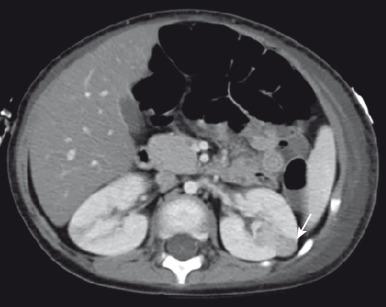
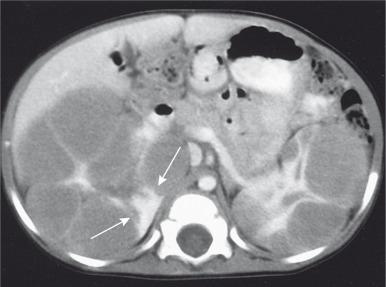
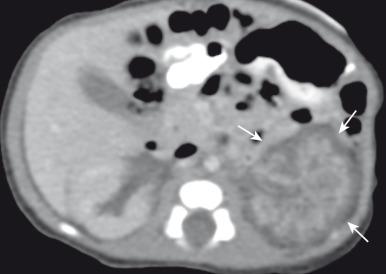
On MRI, nephrogenic rests are isointense to normal renal parenchyma on T1-weighted sequences and isointense to hyperintense on T2-weighted sequences. Similar to CT, nephrogenic rests enhance less than normal renal parenchyma after intravenous gadolinium chelate administration and hence appear as hypointense to enhancing renal parenchyma on T1-weighted postcontrast images. In general, the signal intensity and enhancement of nephroblastomatosis is homogeneous, whereas foci of Wilms tumor tend to be more heterogeneous.
Presently, no specific treatment is advocated for nephrogenic rests / nephroblastomatosis unless Wilms tumor develops. Close radiologic follow-up is recommended for children with genetic abnormalities or syndromes associated with nephroblastomatosis. Children with hemihypertrophy or Beckwith-Wiedemann syndrome are at risk for the development of other embryonal tumors, such as hepatoblastoma. No large studies have been performed to establish the optimal screening interval for Wilms tumor surveillance. A baseline CT of patients with nephroblastomatosis-related genetic abnormalities or syndromes at 6 months of age (or at diagnosis if the patient is older than 6 months), followed by surveillance ultrasound examinations every 3 to 4 months until the child is at least 8 years of age, is recommended on the basis of results from the National Wilms Tumor Studies.
Wilms tumor is one of the most common abdominal malignancies of childhood, and it accounts for approximately 90% of pediatric renal masses. Its peak incidence is at 3 to 4 years of age (80% occur in children <5 years old), but it has been described in the fetus, neonate, teenager, and adult. Clinical presentation includes a palpable mass, abdominal pain, hematuria, and occasionally hypertension (from tumor renin production). As discussed, certain syndromes and genetic abnormalities predispose to development of a Wilms tumor ( e-Fig. 115.4 ). Two loci on chromosome 11 have been implicated in the genesis of Wilms tumors: 11p13 ( WT1 gene —WAGR or Drash syndrome) and 11p15 ( WT2 gene — Beckwith-Wiedemann syndrome or hemihypertrophy). Approximately 5% of children have bilateral Wilms tumor, and up to 7% have multicentric disease. Most Wilms tumors arise from the renal parenchyma; however, extrarenal Wilms tumors rarely may develop in the abdomen or at distant sites.
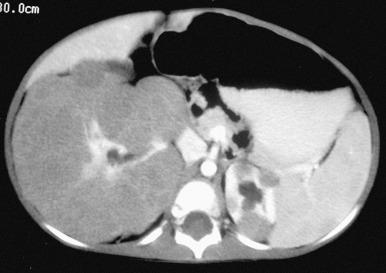
In the United States, tumor stage ( Box 115.1 ) is determined by a combination of preoperative imaging, intraoperative findings, and pathology, while the grade is established on histopathologic examination. Metastatic disease is present in 15% to 20% of patients at presentation and is most commonly seen in the lungs, followed by the liver. The classic triphasic Wilms tumor arises from mesodermal precursors of the renal parenchyma (metanephros) and contains blastemal, stromal, and epithelial elements. The prognosis for tumors with a favorable histology is excellent, even for those at higher stages. Approximately 7% of tumors contain anaplastic elements and have a worse prognosis. In Europe, the staging system is based completely on radiologic findings. Tumors are classified on the basis of their imaging appearance, and chemotherapy is usually given before definitive surgery is performed. In the United States, neoadjuvant chemotherapy is reserved for tumors that are considered unresectable at presentation due to vascular invasion or other features.
A completely resected tumor limited to the kidney with an intact capsule
No biopsy or rupture of tumor before removal
No involvement of vessels or renal sinuses
No tumor at or beyond the margins of resection
Regional lymph nodes are negative for tumor
A completely resected tumor
No tumor at or beyond the margins of resection
Regional lymph nodes are negative for tumor
One or more of the following findings:
Penetration of the renal capsule
Invasion of vasculature extending beyond the renal parenchyma
Residual tumor is present after surgery, confined to the abdomen, with one or more of the following attributes present:
One or more regional lymph nodes are positive for tumor
The tumor is implanted on or penetrating through the peritoneum
The presence of gross unresected tumor or tumor at the margin of resection
Any tumor spillage occurring before or during surgery, including biopsy
The tumor was removed in more than one piece
The presence of hematogenous metastasis (e.g., lung, liver, bone, or brain)
The presence of lymph node metastasis outside the abdomen and pelvis
Wilms tumor in both kidneys
Radiologic evaluation of Wilms tumor is focused on identifying the site(s) of involvement, defining local extent of disease to assist in surgical planning, and evaluating for metastases. Preoperative imaging may include conventional radiography, abdominal sonography, and thoracic, abdominal, and pelvic CT, and/or MRI. The role of F 18 -fluorodeoxyglucose positron emission tomography (FDG-PET) fused with CT (PET-CT) at diagnosis is less clear. PET-CT is often reserved for evaluating for residual disease or recurrence after therapy.
On sonography, Wilms tumor typically appears as a large, heterogeneous intrarenal mass. Some Wilms tumors may contain cystic components, portions of obstructed and entrapped pelvicalyceal systems, or hemorrhagic and necrotic tumor. Identification of vascular invasion with extension into the renal vein, inferior vena cava, or right atrium is important for surgical planning and can be assessed with ultrasound ( e-Fig. 115.5 ), CT ( Fig. 115.6 ), or MRI. The tumor may invade the renal capsule, seed the peritoneal space, or grow directly into the mesentery and omentum. Hepatic metastases, if present, appear as rounded, hypoechoic liver lesions. The contralateral kidney should be carefully evaluated for synchronous Wilms tumor, nephrogenic rests, or nephroblastomatosis.
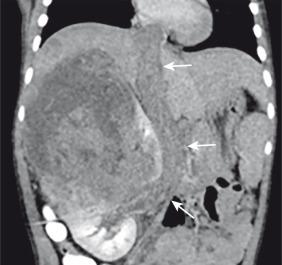
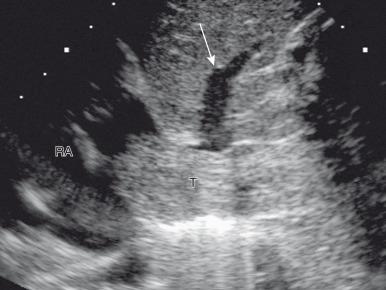
On CT, Wilms tumor typically appears as a large, heterogeneous mass arising from the kidney ( Fig. 115.7 ). The tumor enhances to a lesser extent than does normal renal parenchyma. There is characteristically a rim of enhancing renal tissue surrounding at least a portion of the mass (the so-called “claw sign”), confirming the mass to be of renal origin. Calcifications are uncommon, being present in only about 9% of Wilms tumors ( e-Fig. 115.8 ). CT of the chest is used to identify pulmonary metastases.
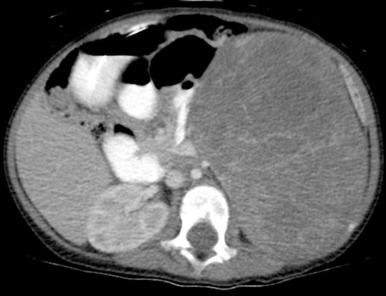
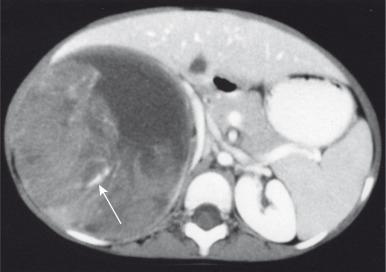
On MRI, a Wilms tumor is isointense with respect to normal renal parenchyma on T1-weighted sequences and heterogeneously hyperintense with respect to normal renal parenchyma on T2-weighted sequences. After administration of intravenous contrast material, a Wilms tumor is typically hypoenhancing relative to normal renal parenchyma ( Fig. 115.9 ). On diffusion-weighted imaging, the tumor typically has heterogeneous signal with areas of impeded diffusion reflecting the high cellularity of the viable tumor. T2-weighted sequences and diffusion-weighted imaging also readily depict liver metastases and enlarged retroperitoneal lymph nodes. Vascular invasion can be assessed on T2-weighted spin-echo images, seen as filling defects instead of the expected vascular flow voids, or as filling defects on T1-weighted postcontrast images.
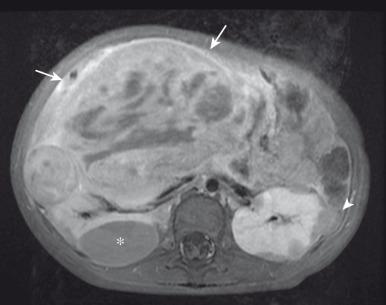
Wilms tumors are typically FDG-avid, but the role of FDG-PET in Wilms evaluation is as yet unclear. FDG-PET can help with a targeted biopsy of a viable Wilms tumor and biologically aggressive elements (e.g., anaplastic Wilms). Currently, FDG-PET is primarily used for evaluating for residual tumor after treatment or confirming local/regional recurrence.
In the United States, therapy for Wilms tumor depends on the stage and primary resectability of the tumor. Up front en bloc resection of the mass and the entire affected kidney is performed if possible, followed by adjuvant chemotherapy. If needed based on disease stage (stage III or IV disease), radiation therapy to the flank, entire abdomen, and/or lungs is considered. If the primary tumor is not initially resectable, or if there is bilateral disease, neoadjuvant chemotherapy is given before resection. In bilateral disease, resection often involves partial nephrectomy as opposed to total nephrectomy to spare as much renal tissue as possible. In Europe, up-front chemotherapy is given before surgery based on data showing possible reduced rates of tumor rupture (stage III disease) when neoadjuvant chemotherapy is given. Ongoing clinical trials are focused on limiting surgical morbidity and therapy-related toxicity, especially with regard to limiting abdominal and pulmonary radiation therapy to only certain subsets of patients. Advancements in therapy over recent decades has resulted in a greater than 90% long-term survival for localized disease and greater than 70% survival for metastatic disease.
Clear cell sarcoma of the kidney accounts for approximately 5% of primary renal tumors in childhood. Clear cell sarcoma occurs in an age group similar to that affected by Wilms tumor (1–4 years of age) and has a male predominance. No familial or syndromic association has been identified. Immunohistochemical staining has shown no characteristic marker pattern, but negativity to the WT1 gene is important.
Imaging features of the primary tumor are similar to those of Wilms tumor, typically a large, heterogeneous renal mass ( Fig. 115.10 ). Distinct from Wilms tumor, clear cell sarcoma has a predilection for bone metastases (even being formerly known as “the bone-metastasizing renal tumor of childhood”). A pathologic diagnosis of clear cell sarcoma necessitates an evaluation of the skeletal system. Bone scintigraphy or a conventional radiographic skeletal survey may be used. However, metastases to lymph nodes, lung, and liver still are seen more frequently than bone metastases.
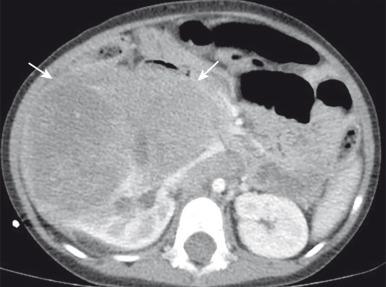
Become a Clinical Tree membership for Full access and enjoy Unlimited articles
If you are a member. Log in here